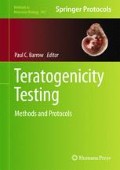Abstract
Frog embryo teratogenesis assay on Xenopus (FETAX) has been routinely used in our laboratory for the last 12 years as a routine developmental toxicity screening test for pharmaceutical candidate compounds. To date, out of more than 400 candidates tested in FETAX, around 60 have also been evaluated in mammalian embryotoxicity studies according to standard ICH protocols.
Compound teratogenic potential in both FETAX and mammalian embryotoxicity studies is determined after analysis of the developmental toxicity characterized by embryotoxicity, growth delay, and/or potential to induce malformations. Based on this experience, the predictivity of FETAX is 81% with a minimal proportion of false positive results.
Access this chapter
Tax calculation will be finalised at checkout
Purchases are for personal use only
References
ASTM (1998) Standard guide for conducting the frog embryo teratogenesis assay-Xenopus (FETAX). Designation E1439-98. In: Annual book of ASTM standards, vol 11.5. American Society for Testing and Materials, Philadelphia, pp 825–836
Mouche I, Malesic L, Gillardeaux O (2011) FETAX assay for evaluation of developmental toxicity. Methods Mol Biol 691:257–269
Bantle JA et al (1998) Atlas of abnormalities: a guide for the performance of FETAX, 2nd edn. OSU Press, Stillwater, OK
Bantle JA et al (1999) Phase III interlaboratory study of FETAX, Part 3: FETAX validation using 12 compounds with and without an exogenous metabolic activation system. J Appl Toxicol 19:447–472
NICEATM (2000) Background review document: frog embryo teratogenesis assay-Xenopus (FETAX). In: Prepared by The National Toxicology Program (NTP) Interagency Center for the Evaluation of Alternative Toxicological Methods. http://iccvam.niehs.nih.gov/docs/fetax2000/brd/FETAX-BRD-all.pdf. Accessed 29 Jan 2012
ICCVAM (2000) Minutes of the Expert Panel meeting on the frog embryo teratogenesis assay-Xenopus (FETAX): a proposed screening method for identifying the developmental toxicity potential of chemicals and environmental samples May 16–18, 2000. http://iccvam.niehs.nih.gov/meetings/minutes/fetaxMin.pdf. Accessed 29 Jan 2012
Picker MD, McKenzie CJ, Fielding P (1993) Embryonic tolerance of Xenopus (Anura) to acidic blackwater. Copeia 4:1072–1081
ICH (2005) ICH harmonised tripartite guideline detection of toxicity to reproduction for medicinal products and toxicity to male fertility S5(R2). http://www.ich.org/fileadmin/Public_Web_Site/ICH_Products/Guidelines/Safety/S5_R2/Step4/S5_R2__Guideline.pdf. Accessed 29 Jan 2012
Schardein JL (2000) Chemically induced birth defects, 3rd edn. Marcel Dekker Inc, New York
DeYoung DJ, Bantle JA, Fort DJ (1991) Assessment of the developmental toxicity of ascorbic acid, sodium selenate, coumarin, serotonin, and 13-cis retinoic acid using FETAX. Drug Chem Toxicol 14:127–141
Fort DJ, McLaughlin DW, Rogers RL, Buzzard BO (2003) Evaluation of the developmental toxicities of ethanol, acetaldehyde, and thioacetamide using FETAX. Drug Chem Toxicol 26:23–34
Dawson DA et al (1988) Evaluation of the developmental toxicity of nicotine and cotinine with frog embryo teratogenesis assay: Xenopus. Teratog Carcinog Mutagen 8:329–338
Dawson DA, Bantle JA (1987) Development of a reconstituted water medium and preliminary validation of the frog embryo teratogenesis assay Xenopus (FETAX). J Appl Toxicol 7(4):237–244
Bantle JA et al (1994) Initial interlaboratory validation study of FETAX: phase I testing. J Appl Toxicol 14(3):213–223
Fort DJ et al (1998) Phase III interlaboratory study of FETAX, Part 2: interlaboratory validation of an exogenous metabolic activation system for frog embryo teratogenesis assay-Xenopus (FETAX). Drug Chem Toxicol 21(1):1–14
Fort DJ, Rayburn JR, Bantle JA (1992) Evaluation of acetaminophen-induced developmental toxicity using FETAX. Drug Chem Toxicol 15(4):329–350
Fort DJ, Stover EL, Bantle JA, Finch RA (2000) Evaluation of the developmental toxicity of thalidomide using frog embryo teratogenesis assay-Xenopus (FETAX): biotransformation and detoxification. Teratog Carcinog Mutagen 20:35–47
ICH (2009) Guidance on nonclinical safety studies for the conduct of human clinical trials and marketing authorization for pharmaceuticals ICH M3(R2). http://www.ich.org/fileadmin/Public_Web_Site/ICH_Products/Guidelines/Multidisciplinary/M3_R2/Step4/M3_R2__Guideline.pdf. Accessed 29 Jan 2012
Author information
Authors and Affiliations
Corresponding author
Editor information
Editors and Affiliations
Rights and permissions
Copyright information
© 2013 Springer Science+Business Media, LLC
About this protocol
Cite this protocol
Leconte, I., Mouche, I. (2013). Frog Embryo Teratogenesis Assay on Xenopus and Predictivity Compared with In Vivo Mammalian Studies. In: Barrow, P. (eds) Teratogenicity Testing. Methods in Molecular Biology, vol 947. Humana Press, Totowa, NJ. https://doi.org/10.1007/978-1-62703-131-8_29
Download citation
DOI: https://doi.org/10.1007/978-1-62703-131-8_29
Published:
Publisher Name: Humana Press, Totowa, NJ
Print ISBN: 978-1-62703-130-1
Online ISBN: 978-1-62703-131-8
eBook Packages: Springer Protocols

